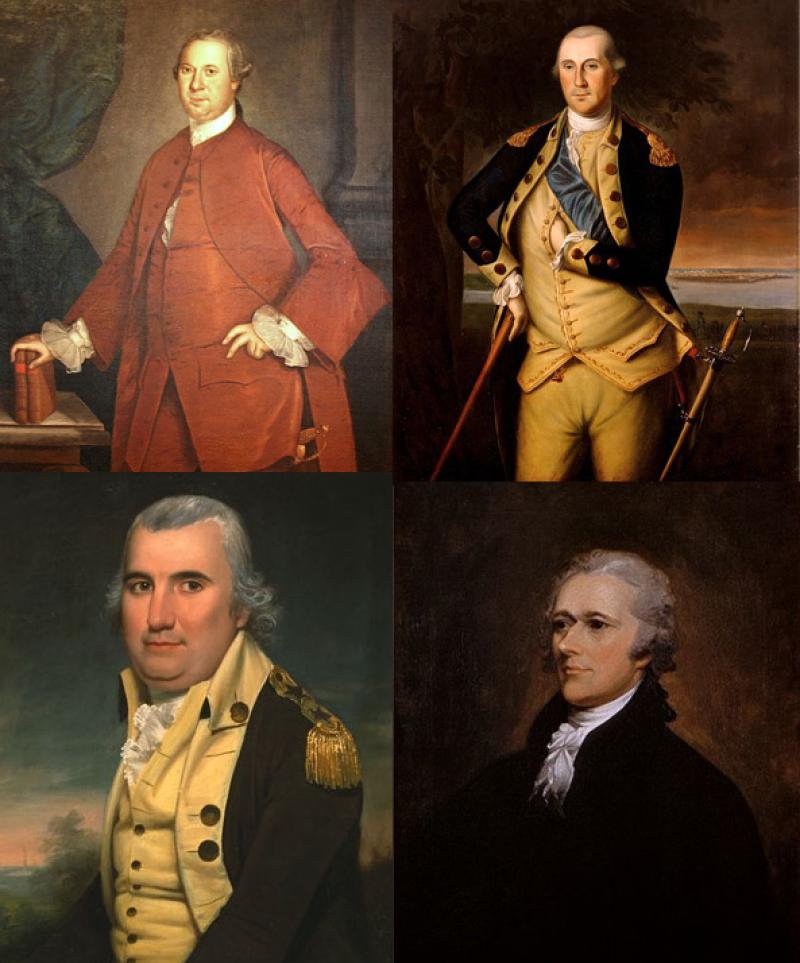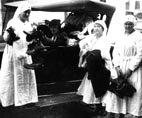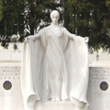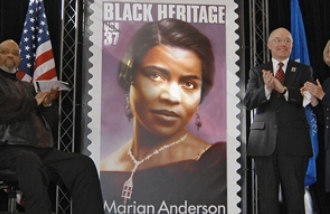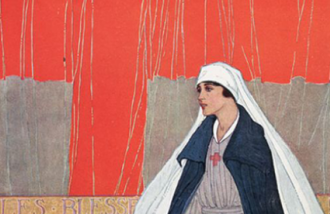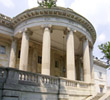This summer from May 26 – July 9, a Dunlap Broadside, as well as the two draft copies of the U.S. Constitution will be on loan at the DAR Museum from the American Independence Museum in Exeter, NH as part of our current exhibition, Remembering the American Revolution: 1776-1890.
On the night of July 4, 1776, Philadelphia printer John Dunlap produced about 200 copies of the newly adopted Declaration of Independence. Today, only 26 of these Dunlap Broadsides survive, and one will be on display at the DAR Museum for a limited time.
Also on loan will be two early drafts of the U.S. Constitution with hand written notes made in the margins. One is a copy of the very first draft of what later became the Constitution and this document was then submitted to the rest of the Convention. The other draft was a later version with other edits incorporated.
Explore this online exhibition to learn more about these documents and their signers and plan to visit the DAR Museum this summer to see the documents in person!
Dunlap Broadside
Immediately after acceptance of the Declaration of Independence, a handwritten copy signed by Congress’s President John Hancock, was sent a few blocks away to Congress’s official printer John Dunlap. Dunlap spent the night furiously printing off copies of the document, creating about 150 “broadsides” (poster-sized copies) of the text.
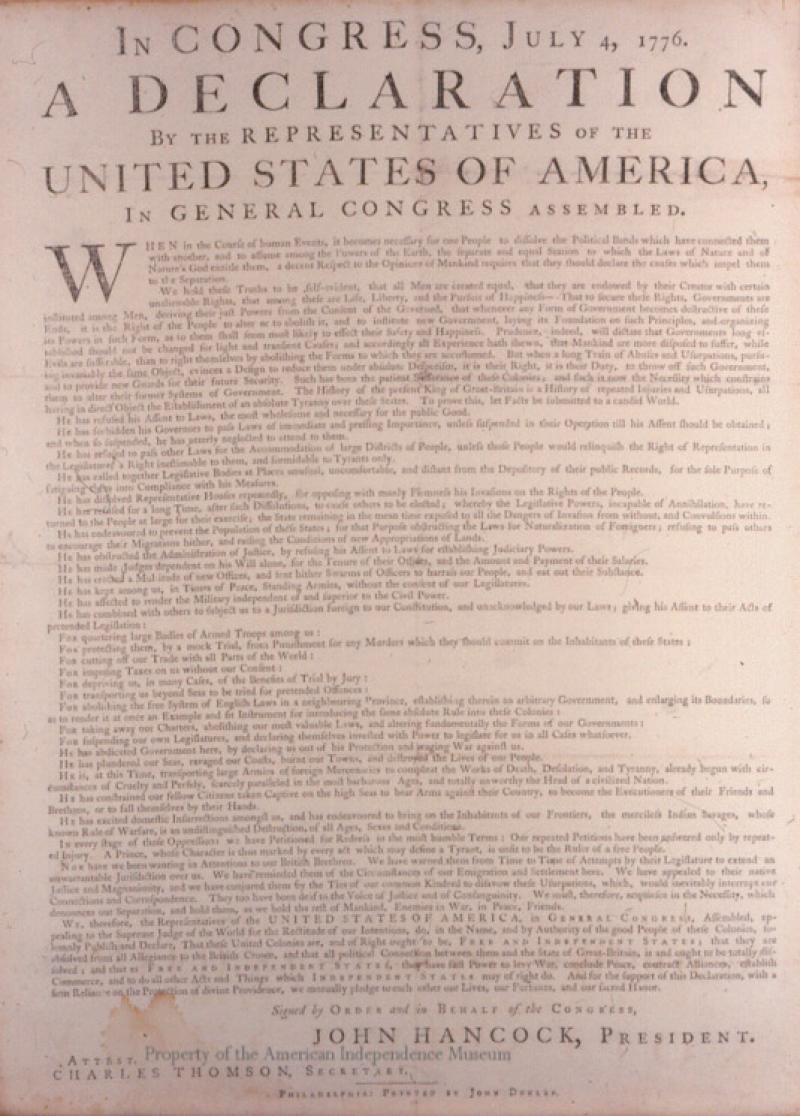
Dunlap Broadside
These Dunlap Broadsides were the first official copies of the Declaration of Independence. The broadsides were then distributed throughout the colonies to be read aloud to the colonists and militia. The copy that was sent to Exeter, New Hampshire arrived on July 16 and was read that day to the townspeople by 22-year-old John Taylor Gilman.
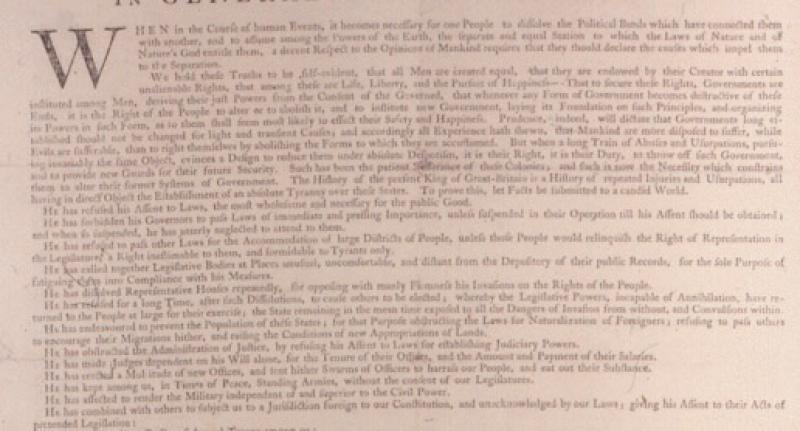
Dunlap Broadside
Today, the American Independence Museum owns one of just twenty six known surviving copies of the Dunlap Broadside. The Museum’s broadside was found in 1985 in the attic of the Ladd-Gilman House, which is owned by the Society of the Cincinnati in the State of New Hampshire. Six years later, the Ladd-Gilman House became part of the American Independence Museum. Now every July, the Dunlap Broadside is proudly displayed and the reading of the broadside by John Taylor Gilman is recreated during the American Independence Festival.
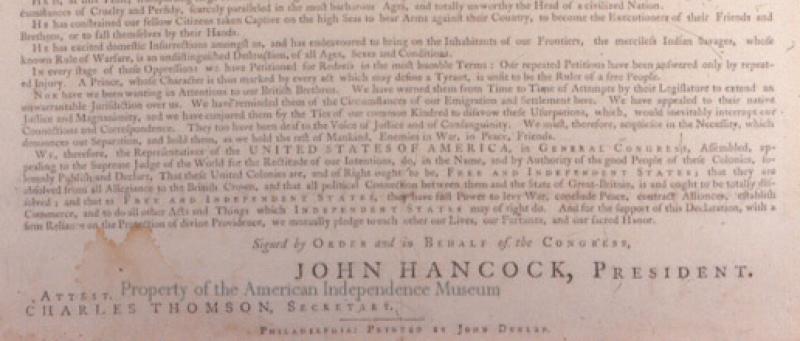
Declaration Signers
The DAR Americana Collection houses a collection of all of the signatures of the signers of the Declaration of Independence. Click here to see their signatures and learn more about each of the signers.
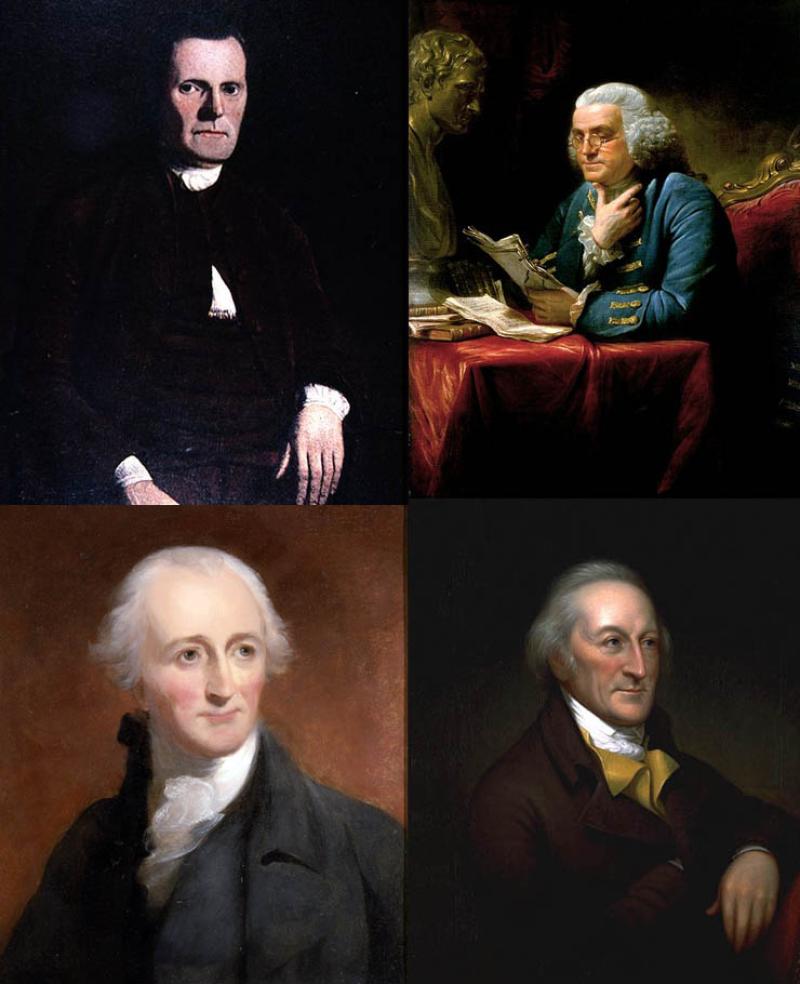
Committee of Detail Draft of the US Constitution
The Committee of Detail prepared a draft Constitution that encompassed the results of the deliberations. Its draft included multiple plans that had been initially discussed in the Convention.
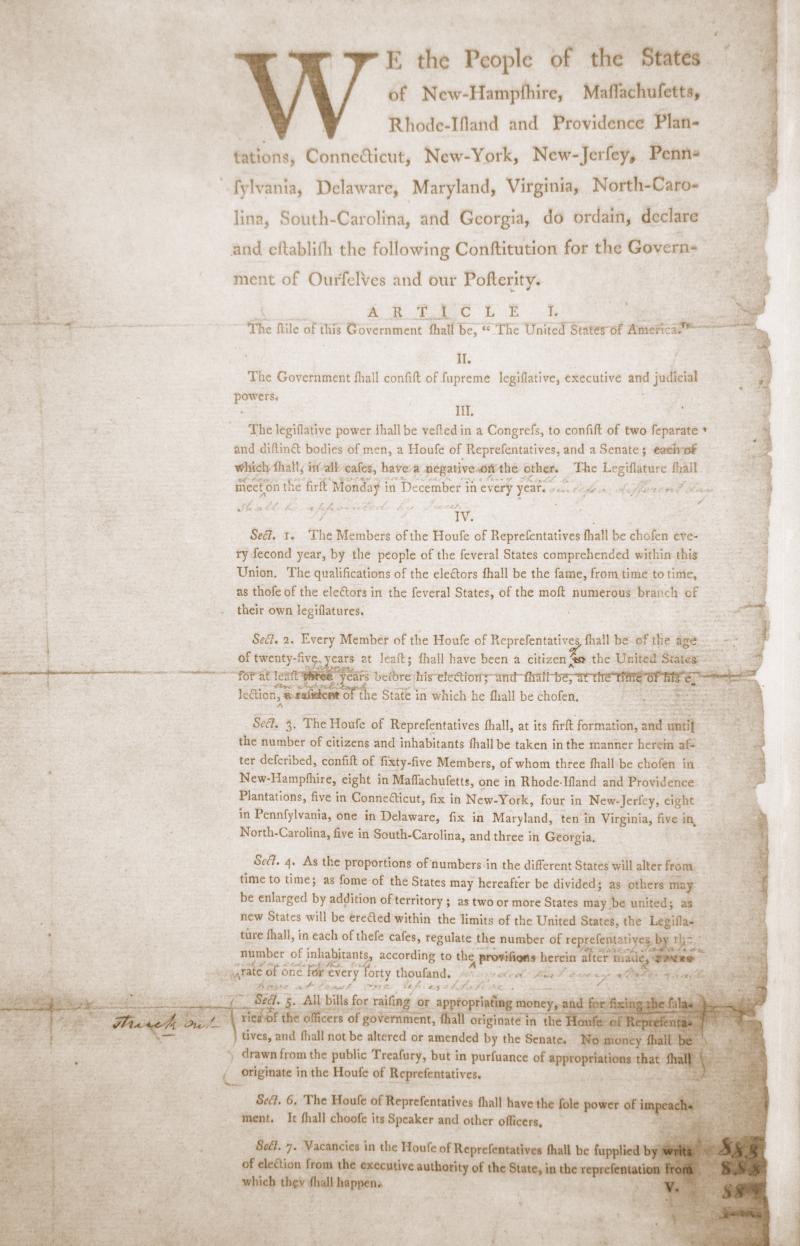
Committee of Detail Draft of the US Constitution
The final report of this Committee, which became the first draft of the Constitution, was the first workable constitutional plan. On August 6, 1787, the Committee submitted the document to the rest of the Convention. Each delegate was presented with this report consisting of seven folio pages enabling space for delegates to make notations.
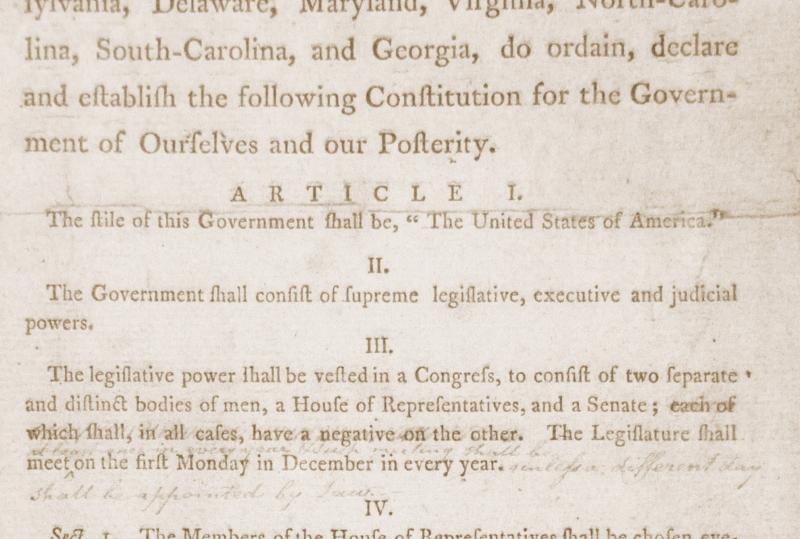
Committee of Detail Draft of the US Constitution
This document is a seven page broadside-style document (with an eighth cover page), printing ink on laid paper with corrections and amendments in iron gall ink by Captain Nicholas Gilman, delegate to the Constitutional Convention, Philadelphia, Pennsylvania, 1787.
As one of the two delegates from New Hampshire, Nicholas Gilman, could only do so much at the Convention due to his late arrival. By the time he arrived much of the major business had already been conducted. He made no speeches and played only a minor part in the deliberations. He did, however, serve on the Committee of Postponed Matters that helped to address concerns from the Committee of Detail. His draft from the Committee of Detail contains hand-written notes about the debates that occurred from August to September 1787.
This draft was presented to the New Hampshire Society of the Cincinnati by John Gardiner Gilman President of the New Hampshire Society of the Cincinniati 1896-1905 and grandnephew of Nicholas Gilman. Presumably it was handed down in the Nicholas Gilman family.
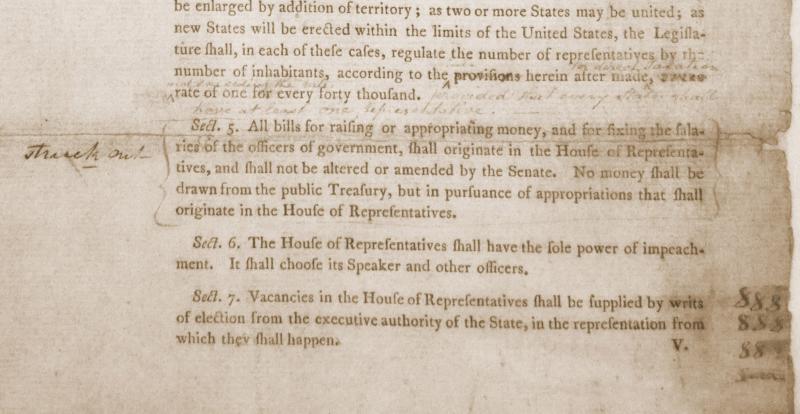
The Members of the Committee of Detail
Nathaniel Gorham of Massachusetts
Nathaniel Gorham was born in Charlestown, Massachusetts in 1738. As a young man, he was apprenticed as a merchant before he began his own business. Gorham entered public service as a notary, but was soon elected to the colonial legislature and later served on the Massachusetts General Court. He went on to represent his state as a delegate to the provincial congress from 1774 to 1775 as well as the Continental Congress from 1782 to 1783 and 1785 to 1787. Gorham also represented his state at the Constitutional Convention. Here he was a nationalist who served as the chairman of the Committee of the Whole and sat on the Committee of Detail. After the convention he worked to ratify the Constitution at the Massachusetts ratifying convention.
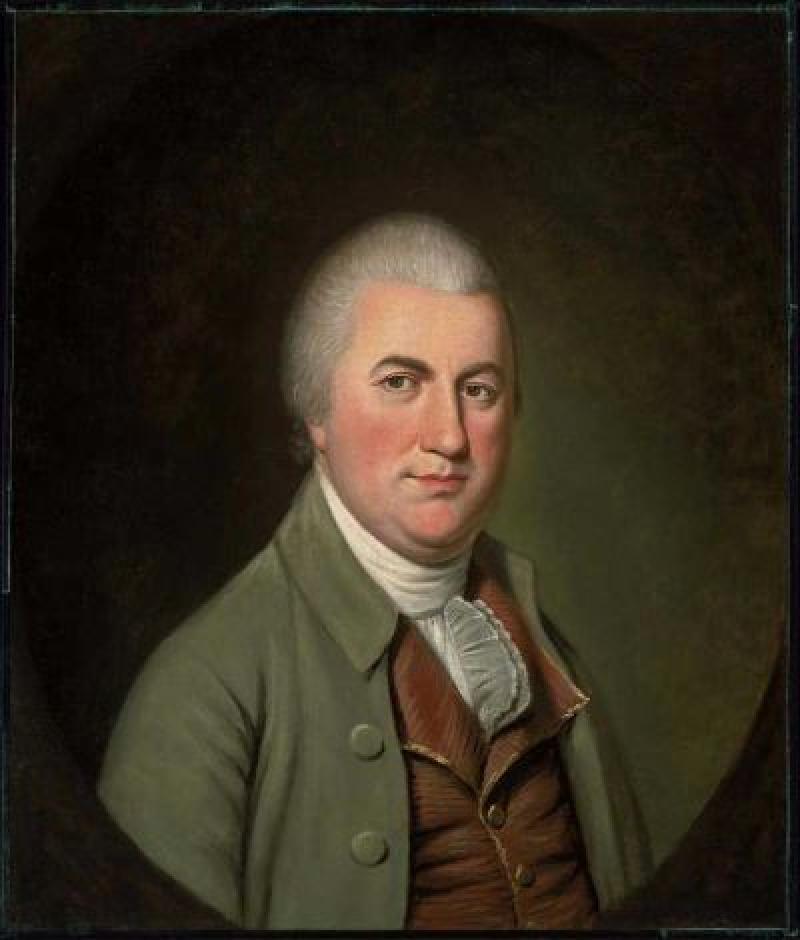
The Members of the Committee of Detail
Nathaniel Gorham of Massachusetts
The DAR Americana Collection houses signatures of all of the signers of the Constitution. This is a letter from Nathaniel Gorham dated Charles Town, 1783.
Americana Collection, acc. 2000X-07

The Members of the Committee of Detail
Nathaniel Gorham of Massachusetts
The DAR Americana Collection houses signatures of all of the signers of the Constitution. This is a letter from Nathaniel Gorham dated Charles Town, 1783.
Americana Collection, acc. 2000X-07
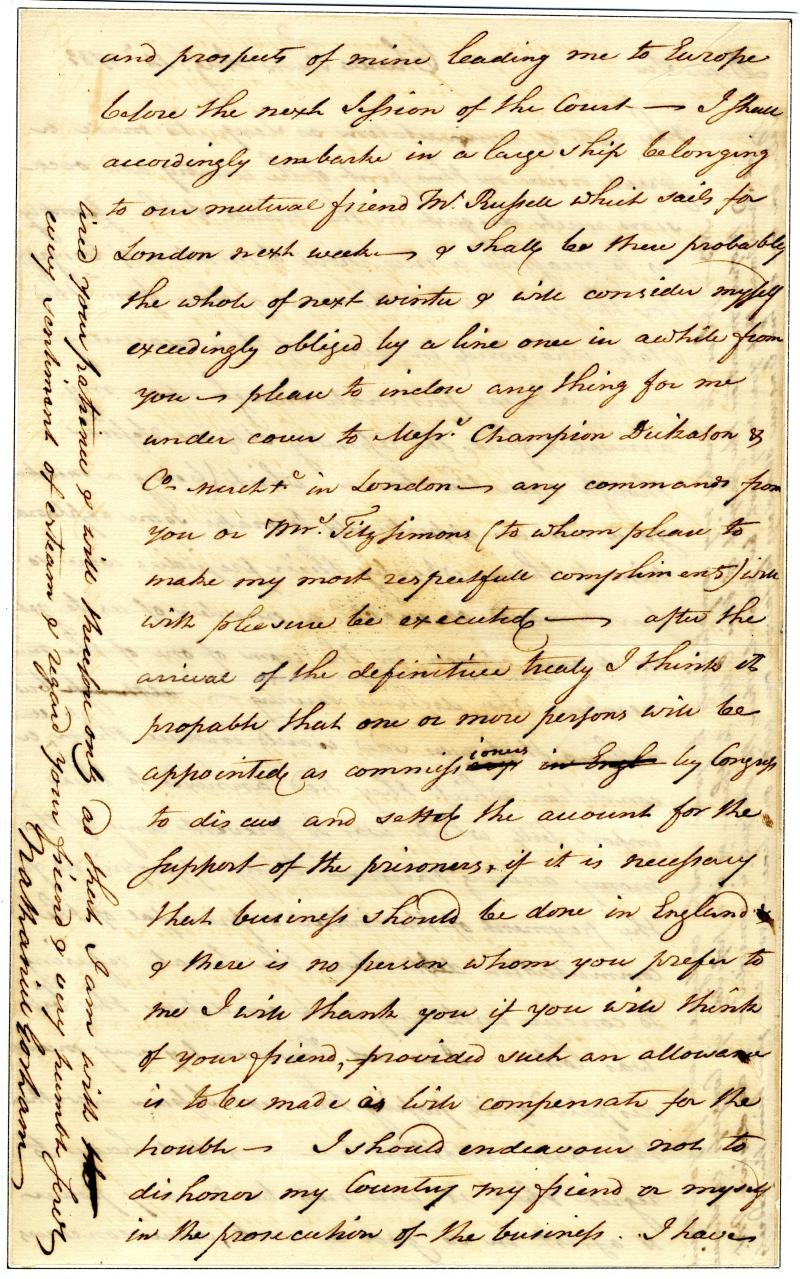
The Members of the Committee of Detail
John Rutledge of South Carolina
John Rutledge’s reputation as a barrister and governor preceded him. He spoke often and convincingly especially in defense of the slave trade. He is at least partly responsible for keeping any prohibitive language regarding slavery out of the Constitution. He chaired the five-person Committee of Detail, responsible for drafting the Constitution, and is considered a major contributor to the document.
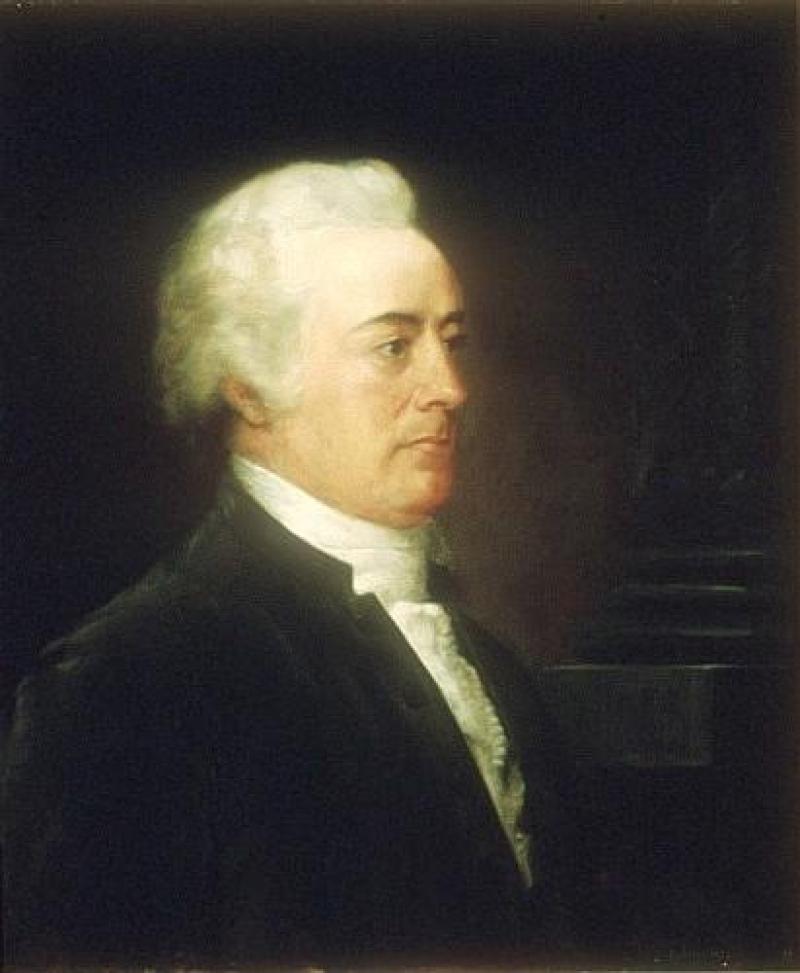
The Members of the Committee of Detail
John Rutledge of South Carolina
The DAR Americana Collection houses signatures of all of the signers of the Constitution. This is a letter from John Rutledge objecting to an expedition against St. Augustine. Citing a lack of “adequate forces” and “approaching inclement weather,” Rutledge explains to a military leader that he “cannot, therefore, agree to cooperate in a measure which I fear would terminate only in the deaths of some brave men.” 1777.
Americana Collection, acc. 2000X-67
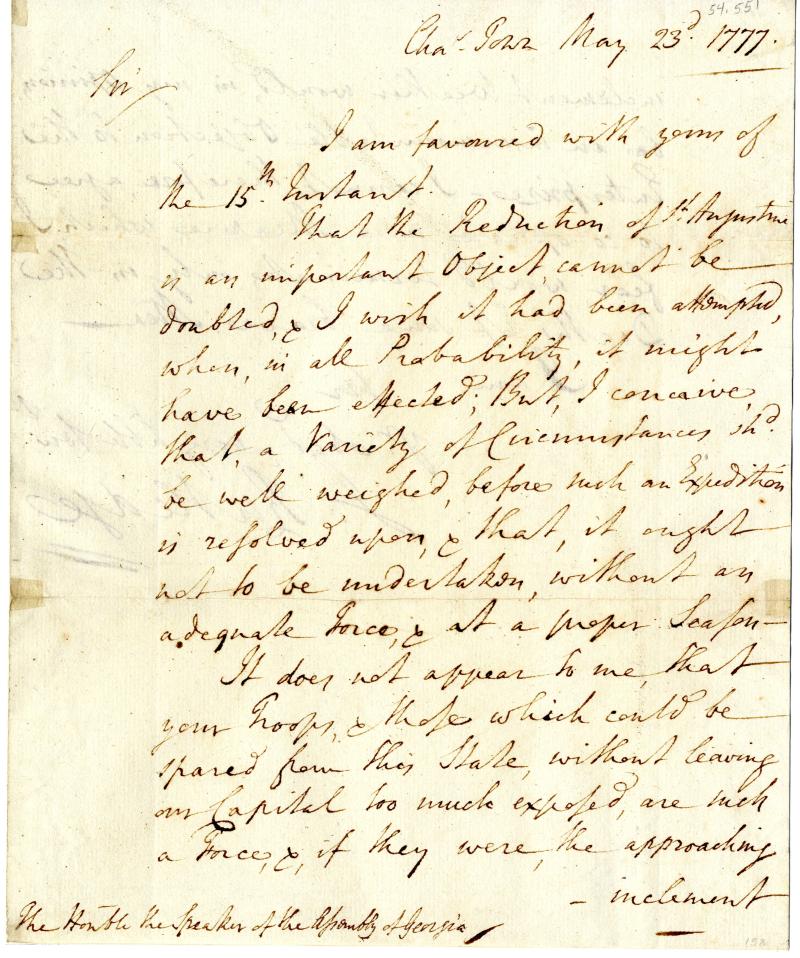
The Members of the Committee of Detail
John Rutledge of South Carolina
The DAR Americana Collection houses signatures of all of the signers of the Constitution. This is a letter from John Rutledge objecting to an expedition against St. Augustine. Citing a lack of “adequate forces” and “approaching inclement weather,” Rutledge explains to a military leader that he “cannot, therefore, agree to cooperate in a measure which I fear would terminate only in the deaths of some brave men.” 1777.
Americana Collection, acc. 2000X-67
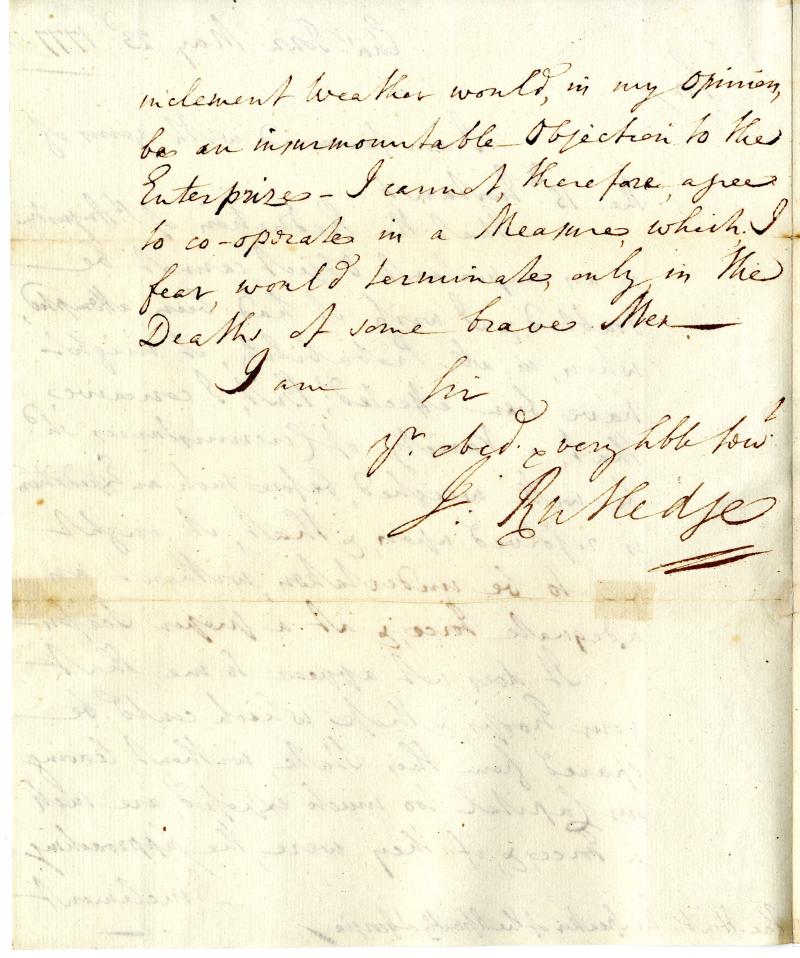
The Members of the Committee of Detail
James Wilson of Pennsylvania
James Wilson was a gifted orator who joined the more radical members of the Continental Congress in demanding separation from the crown. He was born in Scotland in 1742. He relocated to America in his early twenties and, although he began his career as a teacher, he soon changed his focus to law. He was admitted to the bar in Philadelphia in 1767 and proceeded to found a lucrative and successful law practice. In 1774 Wilson joined the local committee of correspondence and wrote a widely circulated pamphlet in which he argued that Parliament had no authority to pass laws for the colonies. He was elected to the Continental Congress in 1775 where his committee work focused on military matters and Indian affairs. From 1779 to 1783 Wilson served as Advocate General for France in America. His duties concerned maritime and commercial matters. He also provided legal advice to Loyalists and their sympathizers. In the meantime, Wilson's personal affairs were precarious as he found himself deep in debt as a result of engaging in profiteering and land speculation schemes. His involvement in such intrigues culminated in an attack on his home in Philadelphia in 1779 when a mob set out to intimidate the political leadership during a food shortage. After working closely with Robert Morris to resolve the nation's financial affairs, Wilson was appointed a director of the Bank of North America in 1781. In 1787 he was elected to the Constitutional Convention—one of the highlights of his career. Wilson was a leader both on the drafting committee and in floor debates. He was appointed associate justice of the United States Supreme Court in 1789; however, he was often suspected of using his influence to favor land speculators. Heavily in debt and suffering from physical and mental fatigue that made it impossible for him to work, James Wilson died in 1798, two weeks before his 56th birthday.
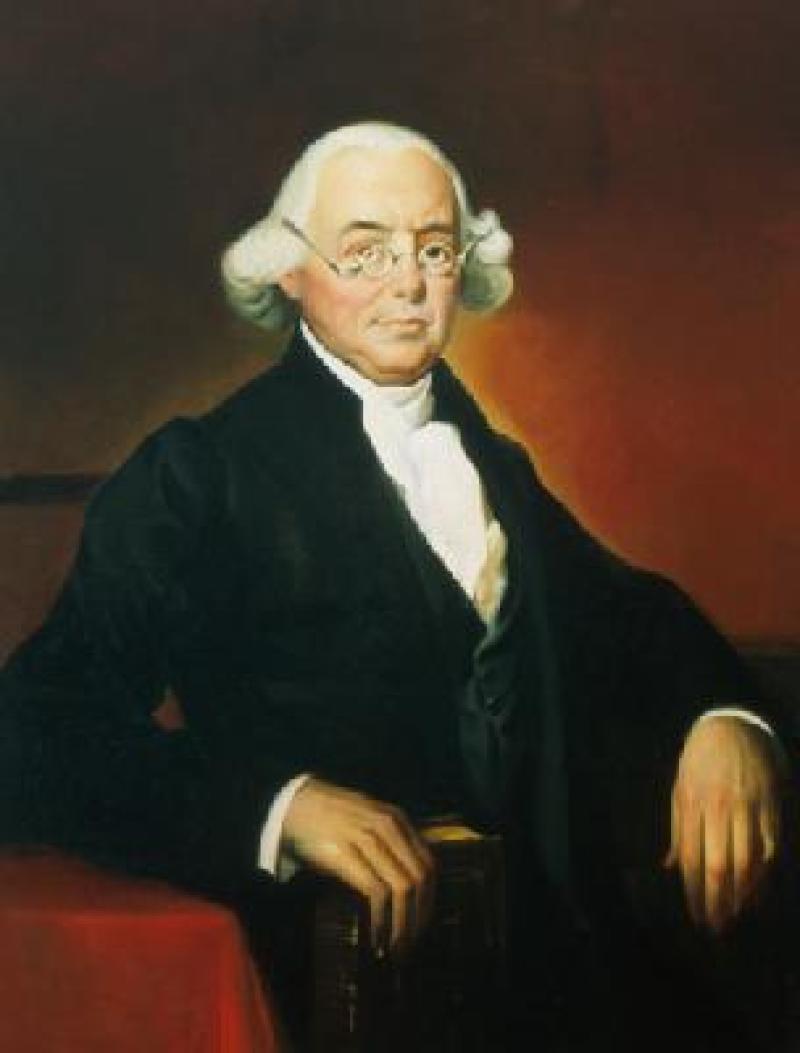
The Members of the Committee of Detail
James Wilson of Pennsylvania
The DAR Americana Collection houses signatures of all of the signers of the Constitution. This is a letter from James Wilson to Samuel Wallis, a surveyor and assessor, regarding an opportunity to purchase land to connect the Wappassening tract to the Susquehanna River, 1792.
Americana Collection, acc. 2000X-30
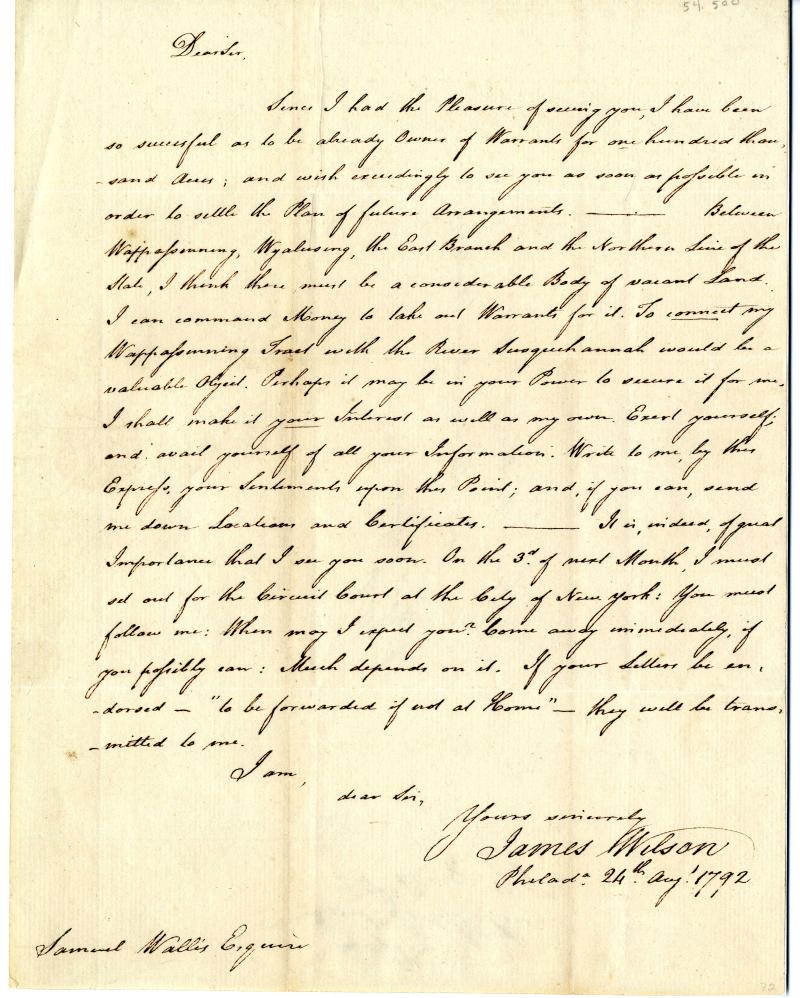
The Members of the Committee of Detail
Oliver Ellsworth of Connecticut
Connecticut delegate Oliver Ellsworth left the Convention before signing the Constitution. However, because of his role in creating the Connecticut Compromise and on the Committee of Detail, he was instrumental to the success of the Constitution. Ellsworth was appointed Chief Justice of the Supreme Court in 1796.
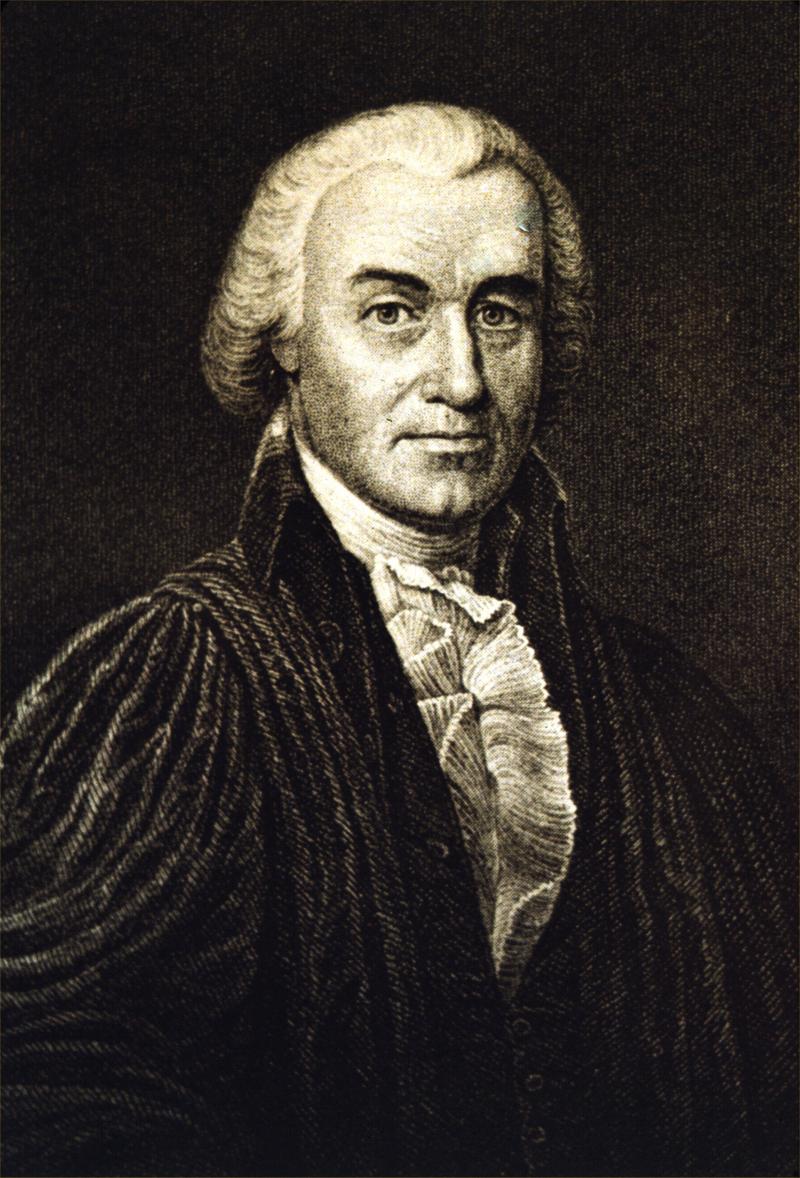
The Members of the Committee of Detail
Oliver Ellsworth of Connecticut
The DAR Americana Collection houses signatures of all of the signers of the Constitution. Letter from Oliver Ellsworth of Connecticut, Chief Justice U.S., to the Honorable W. Read, regretting his vacating Senate seat. Philadelphia, 1794.
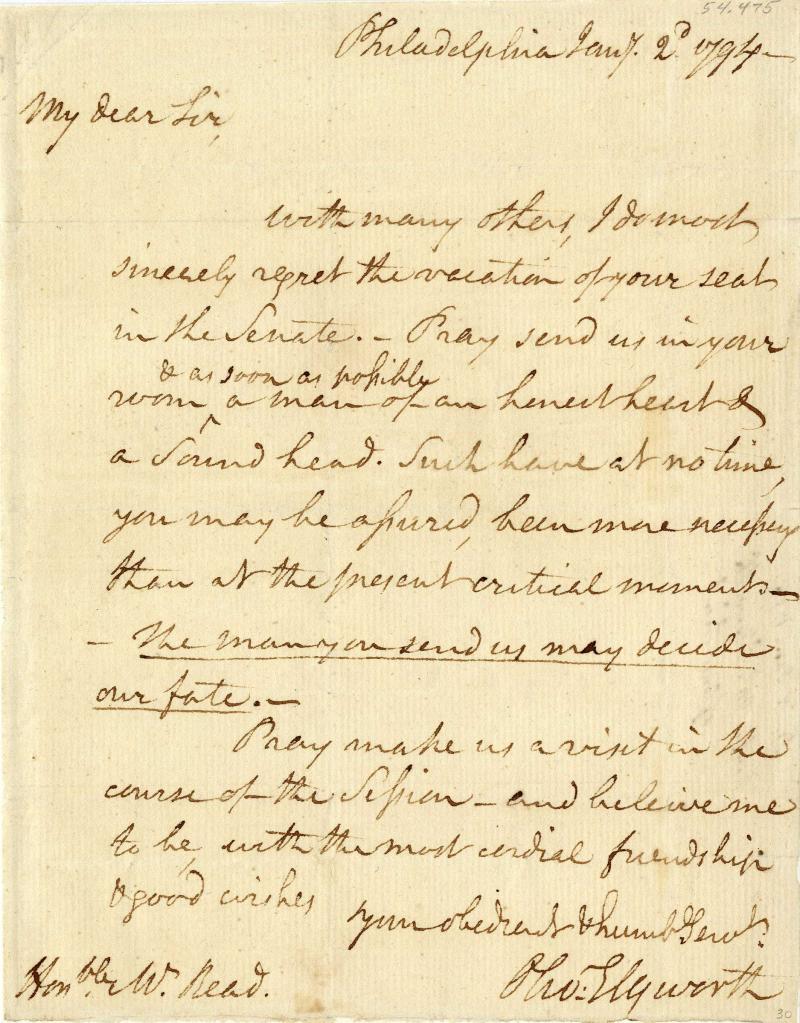
The Members of the Committee of Detail
Edmund Randolph of Virginia
Four delegates from Virginia did not sign the Constitution. James McClurg, a physician who favored a strong federal government, left the Convention in August. George Wythe, who signed the Declaration of Independence and was a friend and mentor to Thomas Jefferson, also left the proceedings early. George Mason and Edmund Randolph, however, were present but refused to sign. As the framer of the Virginia Declaration of Rights, George Mason thought a Bill of Rights was an essential component and would not sign the Constitution if it was not included. Edmund Randolph argued that the Constitution was flawed and gave too much power to the one man in the executive office. All four men eventually supported ratification of the Constitution.
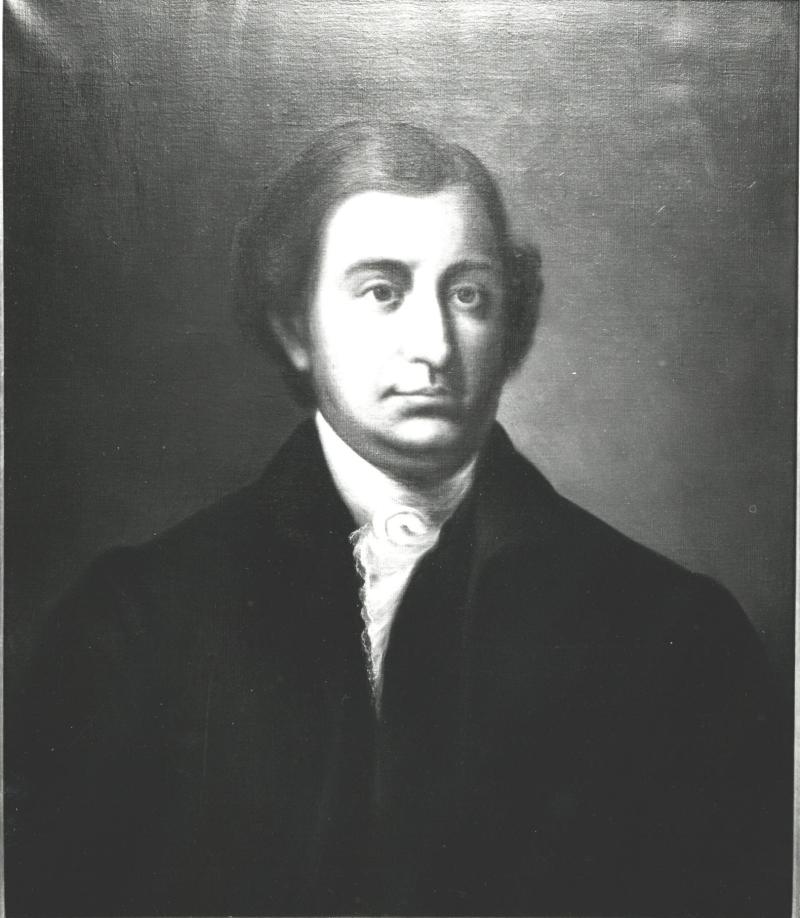
The Members of the Committee of Detail
Edmund Randolph of Virginia
The DAR Americana Collection houses signatures of all of the signers of the Constitution. Letter from Edmund Randolph of Virginia to Mr. Mathew Foler, Hanover, regarding court debt case against a Mr. Gist. Also signed by John Wickham, attorney for Gist. Richmond, 1809.
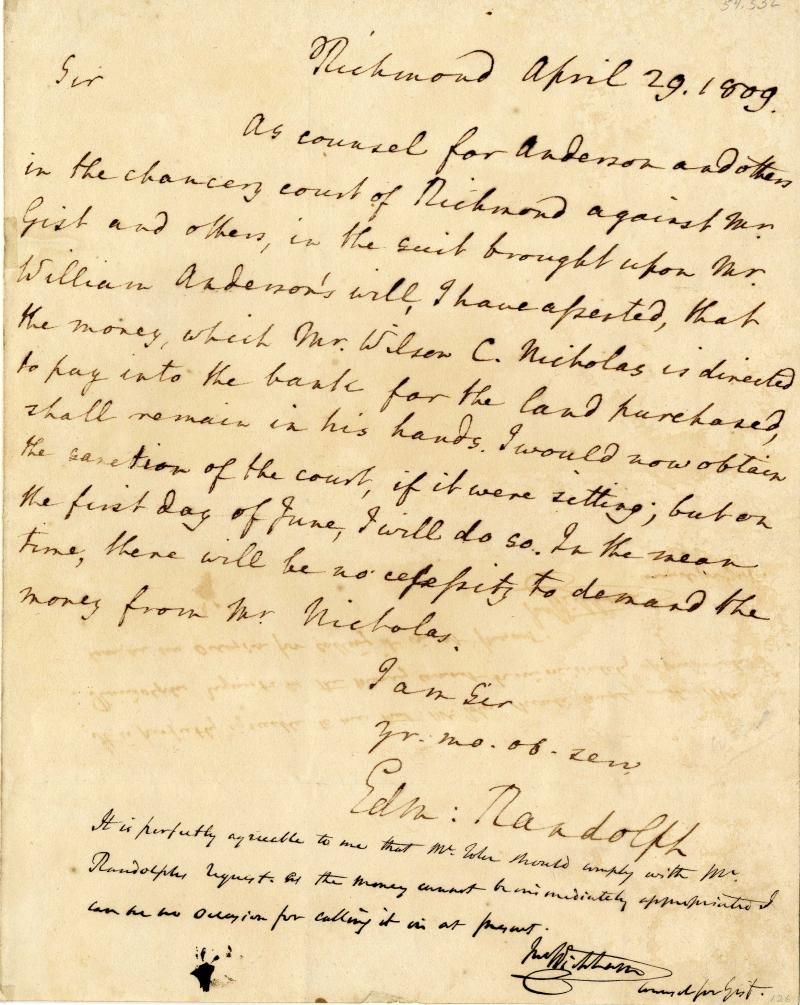
Commitee of Style Draft of the US Constitution
The Committee of Style and Arrangement worked together "to revise the style of, and arrange, the articles which have been agreed to by the House." The Committee incorporated all of the changes discussed in the Convention and the delegates debated each paragraph of the revised draft.
Gouverneur Morris is credited with providing the preamble phrase: "We the people of the United States, in order to form a more perfect union"---a dramatic change from the opening of the previous version.
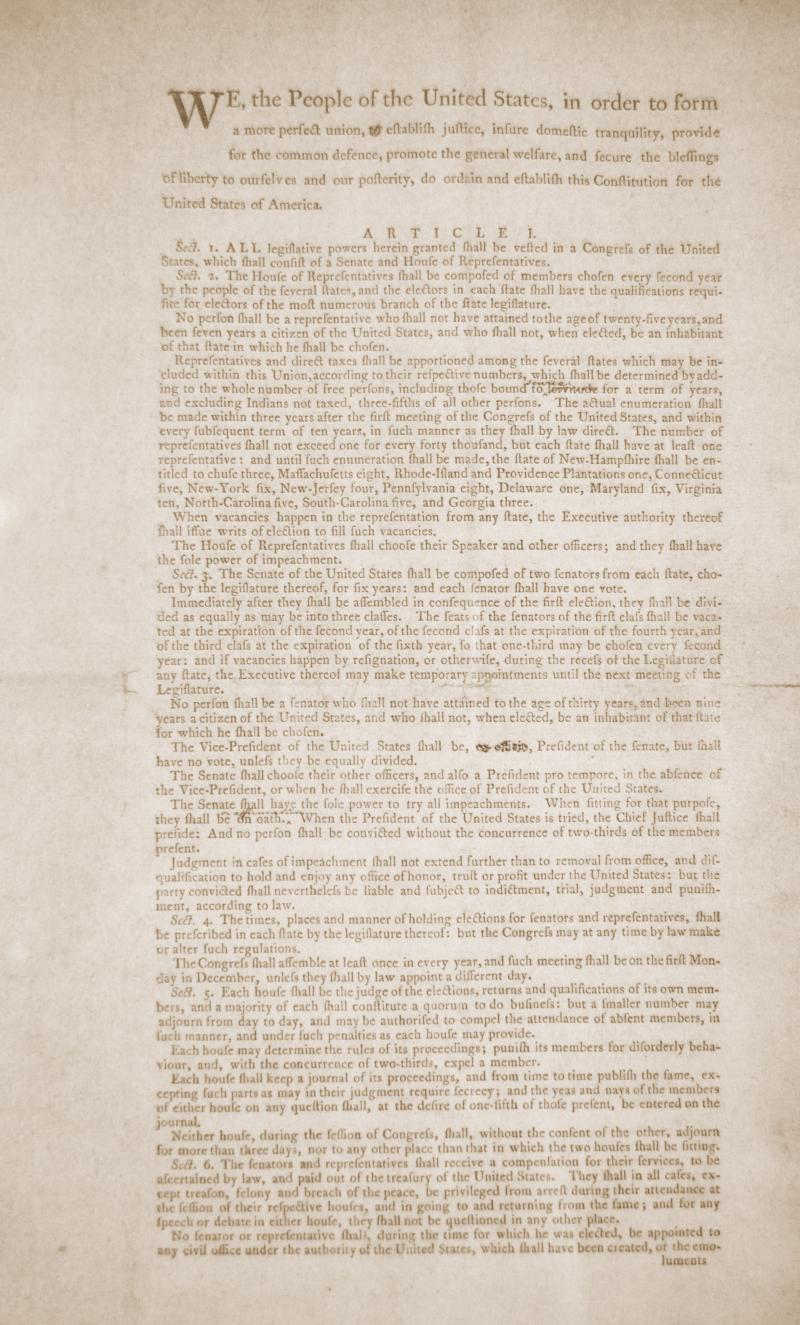
Commitee of Style Draft of the US Constitution
The Committee reduced the twenty-three articles of the amended draft to seven plus two resolutions that dealt with the mechanics of ratifying the Constitution and inaugurating the new government. Copies were then printed and distributed to all of the delegates at the Convention. Few changes were made resulting in the Constitution being adopted on September 17, 1787.
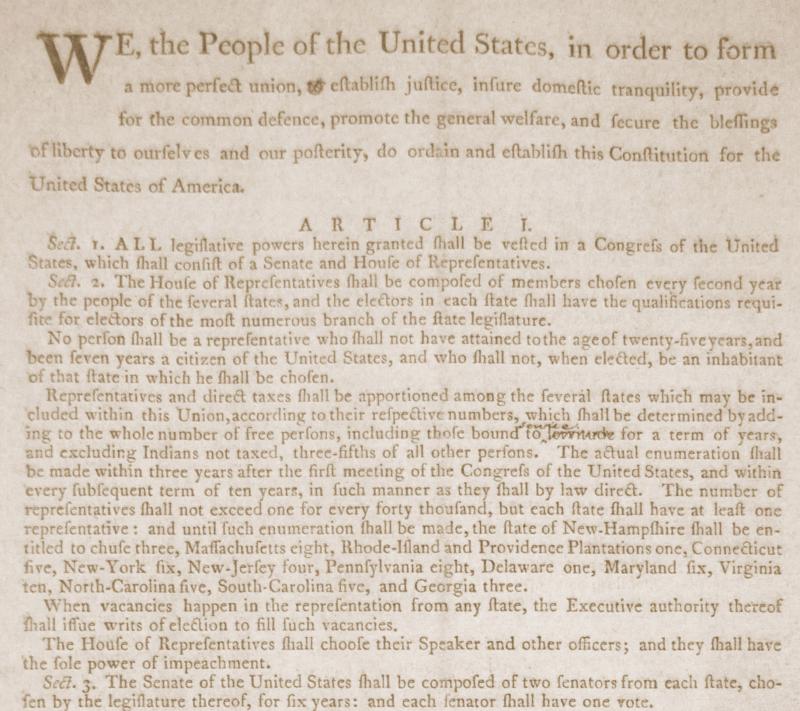
Commitee of Style Draft of the US Constitution
This document is two folio sheets (four pages) broadside-style document, printing ink on laid paper with corrections and amendments in iron gall ink by Rufus King, delegate to the Constitutional Convention, Philadelphia, Pennsylvania, 1787.
Rufus King, a representative from Massachusetts, was not only one of the most youthful of the delegates at Philadelphia, but also one of the most important. He numbered among the most capable orators. Furthermore, he attended every session. Although he came to the Convention unconvinced that major changes should be made in the Articles of Confederation, his views underwent a startling transformation during the debates. With Madison, he became a leading figure in the nationalist caucus. He served with distinction on the Committee of Postponed Matters and the Committee of Style. He also took notes on the proceedings included on his draft from the Committee of Style.
This draft was presented to the New Hampshire Society of the Cincinnati by John Gardiner Gilman President of the New Hampshire Society of the Cincinniati 1896-1905 and grandnephew of Nicholas Gilman. Presumably it was handed down in the Nicholas Gilman family.
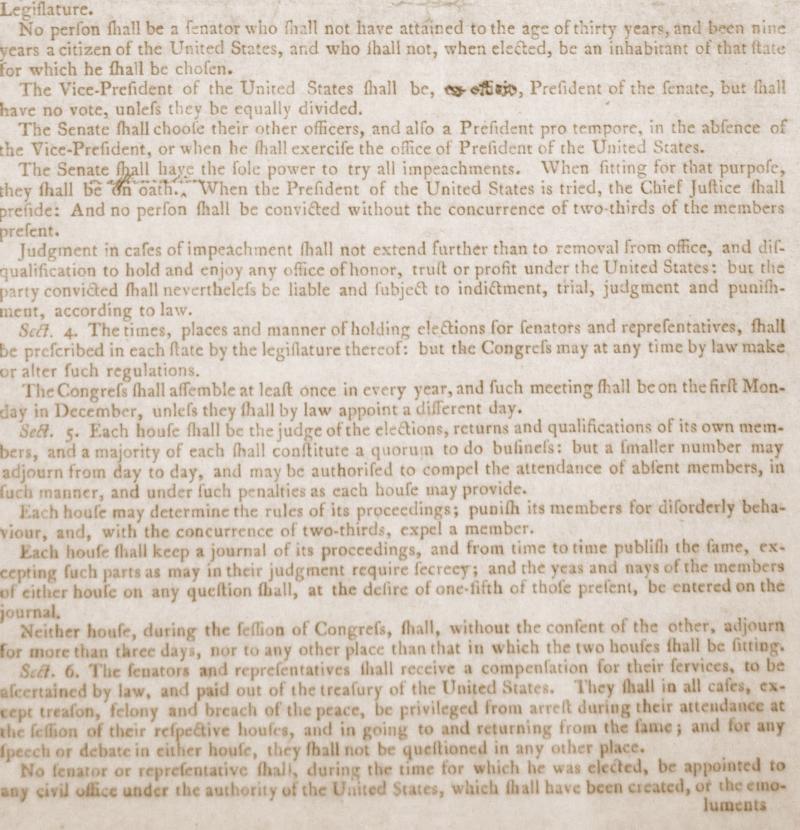
The Members of the Committee of Style
William Samuel Johnson of Connecticut
After William Samuel Johnson arrived at the Convention, he did not miss a single day of the proceedings. As a career politician for Connecticut, he debated passionately in favor of equal representation for small states. He strongly supported the Connecticut Compromise and served as chair of the Committee of Style which molded the final version of the Constitution. Johnson worked toward ratification in Connecticut. He later served in the United States Senate and as president of Columbia College.
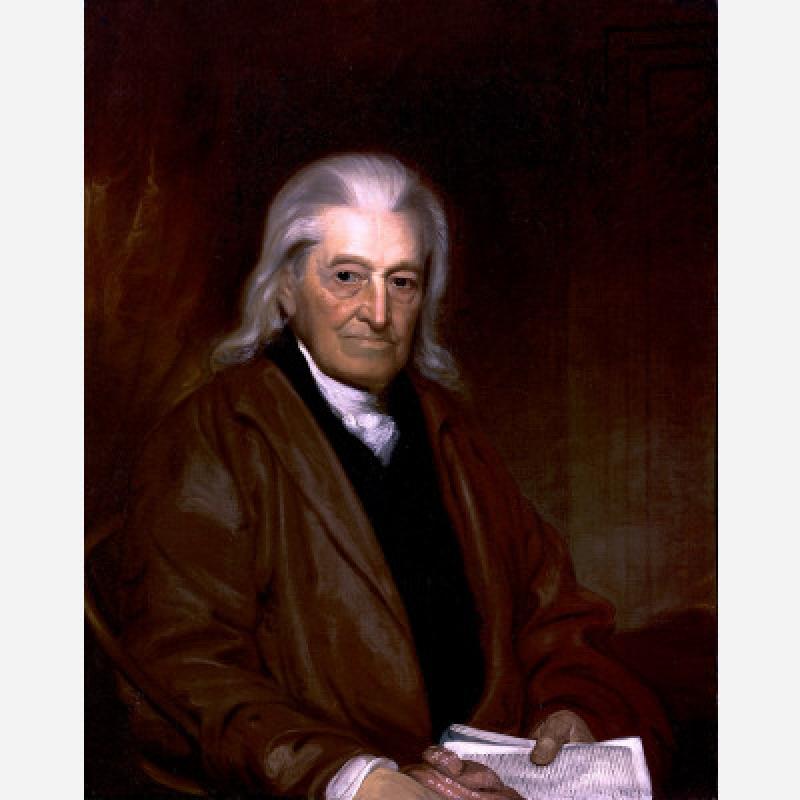
The Members of the Committee of Style
William Samuel Johnson of Connecticut
The DAR Americana Collection houses signatures of all of the signers of the Constitution. This is a letter from William Samuel Johnson to Oliver Woolcot regarding sending papers, 1755.
Americana Collection, acc. 3131x-25
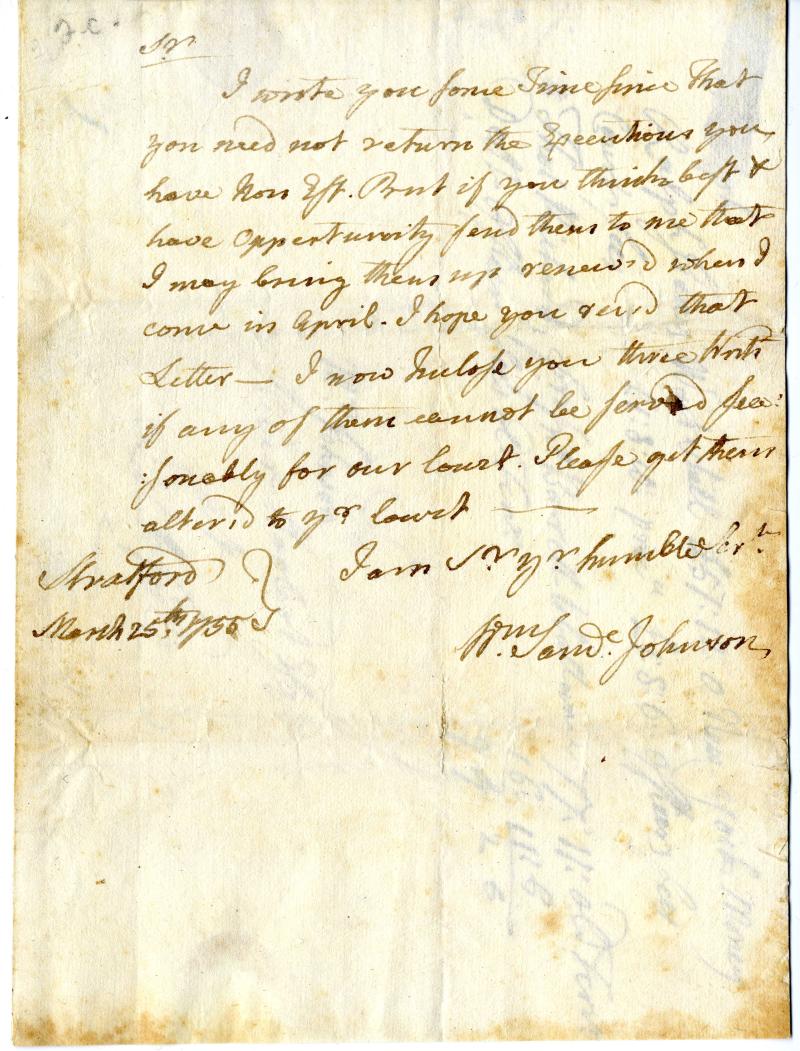
The Members of the Committee of Style
Alexander Hamilton of New York
Although he proposed a plan during the Convention that so mimicked the British system of government that opponents accused him of supporting a monarchy for America, Alexander Hamilton was strongly in favor of the Constitution. Originally trained as a lawyer, Hamilton’s extensive service to his country included serving as General Washington’s aide-de-camp during the Revolutionary War. He was also a member of the Continental Congress and founder of the Bank of New York. In favor of a strong national government and no friend of states’ rights, Hamilton led the Annapolis Convention which was convened to “remedy defects of the federal government” caused in part by the inadequate Articles of Confederation. After deliberating for four days, the delegates called for a constitutional convention. Hamilton was an active participant in Philadelphia. He co-authored the Federalist Papers which are still the preeminent source for Constitutional interpretation. Hamilton also served on the Committee of Style and Arrangement. As the nation’s first Secretary of the Treasury, he was the architect of the country’s first financial system which included the establishment of a national bank. He was founder of the Federalist Party and instrumental in assisting with the management of American foreign relations. Hamilton was killed in a duel by political enemy Aaron Burr in 1804.
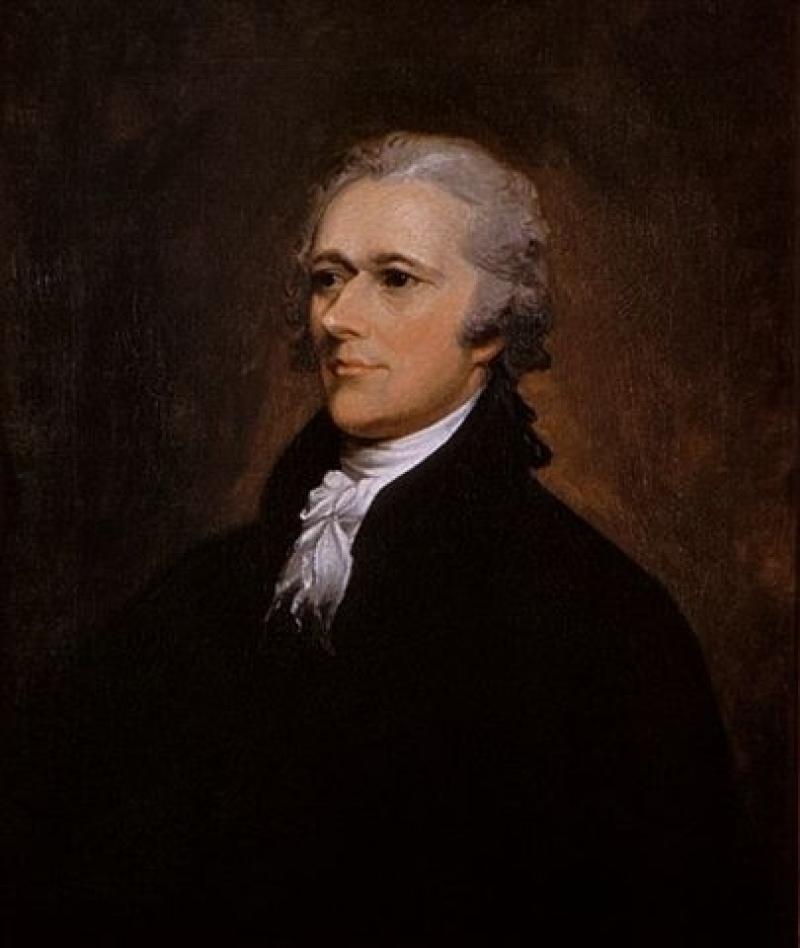
The Members of the Committee of Style
Alexander Hamilton of New York
The DAR Americana Collection houses signatures of all of the signers of the Constitution. This is a letter to James Watson regarding The Manufacturing Society and Mr. Samuel Ogden as superintendent, signed by Alexander Hamilton, 1792.
Americana Collection, acc. 2000x-13

The Members of the Committee of Style
Alexander Hamilton of New York
The DAR Americana Collection houses signatures of all of the signers of the Constitution. This is a letter to James Watson regarding The Manufacturing Society and Mr. Samuel Ogden as superintendent, signed by Alexander Hamilton, 1792.
Americana Collection, acc. 2000x-13

The Members of the Committee of Style
Alexander Hamilton of New York
The DAR Americana Collection houses signatures of all of the signers of the Constitution. This is a letter to James Watson regarding The Manufacturing Society and Mr. Samuel Ogden as superintendent, signed by Alexander Hamilton, 1792.
Americana Collection, acc. 2000x-13
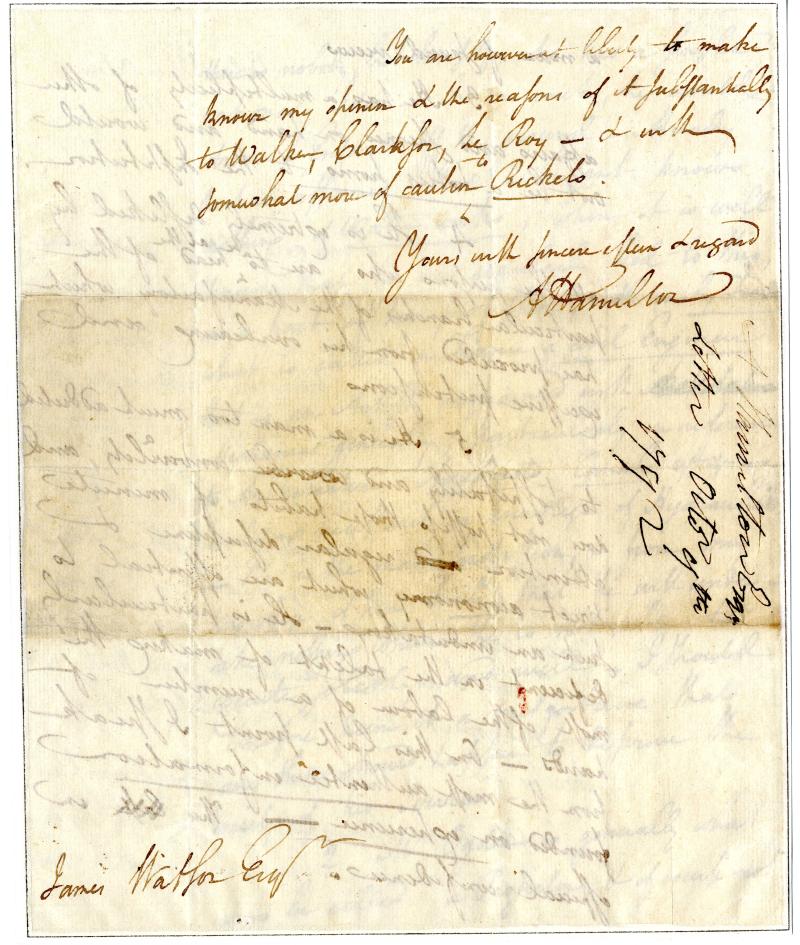
The Members of the Committee of Style
Gouverneur Morris of Pennsylvania
Gouverneur Morris was there at the very start, but then was called away to New York for a month. Despite his absence, he made 173 speeches – more than any other delegate. At the Convention, Morris was among the large-state nationalists who favored the Virginia Plan, and he believed that taxes should be paid in proportion to a state’s population. He did not want the president to be chosen by Congress, but rather by citizens. He was also one of the most frequent and forceful voices against slavery. Morris’s greatest contribution to the Convention was his principal role, as a member of the Committee on Style, in rephrasing the Constitution into what we know today. The most often quoted words from the preamble to the Constitution are attributed to Gouverneur Morris.
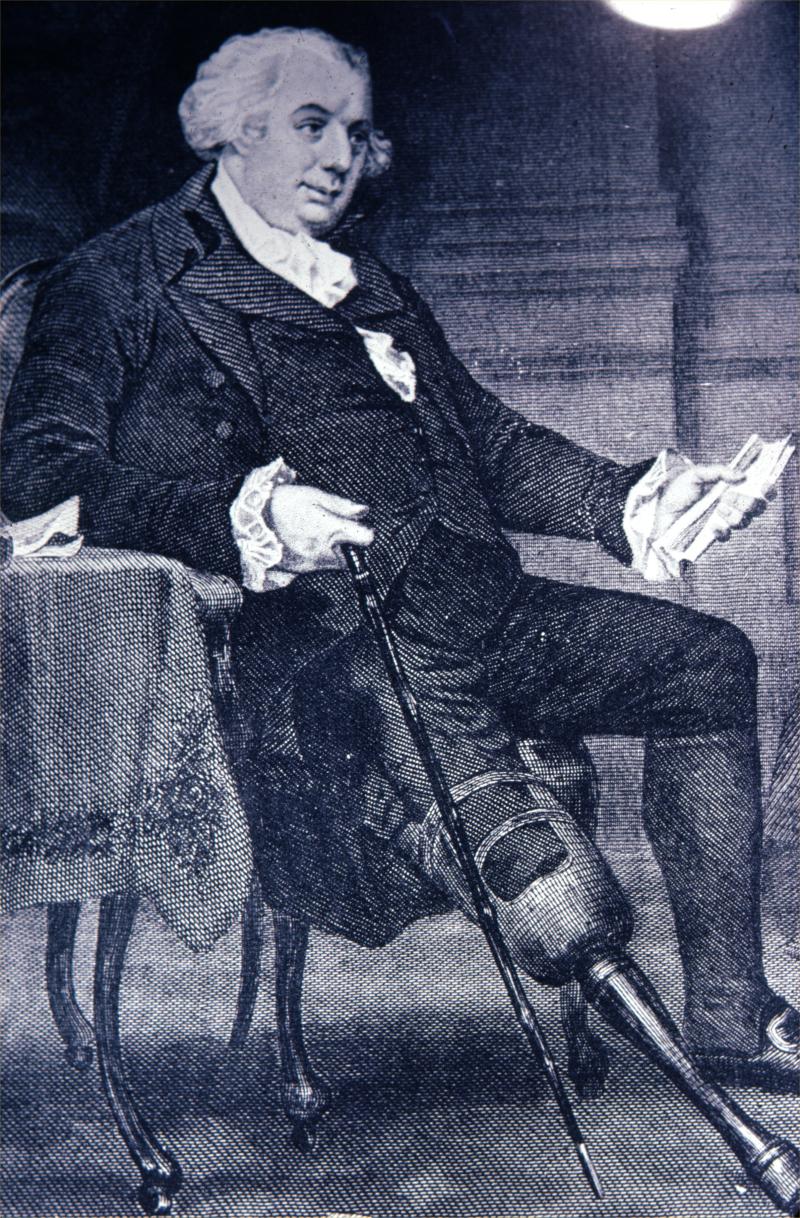
The Members of the Committee of Style
Gouverneur Morris of Pennsylvania
The DAR Americana Collection houses signatures of all of the signers of the Constitution. This is a letter from Gouverneur Morris to Messrs. Ruellan and Company of Le Havre, France, consulting a delivery of American goods, 1789.
Americana Collection, acc. 2000X-28a
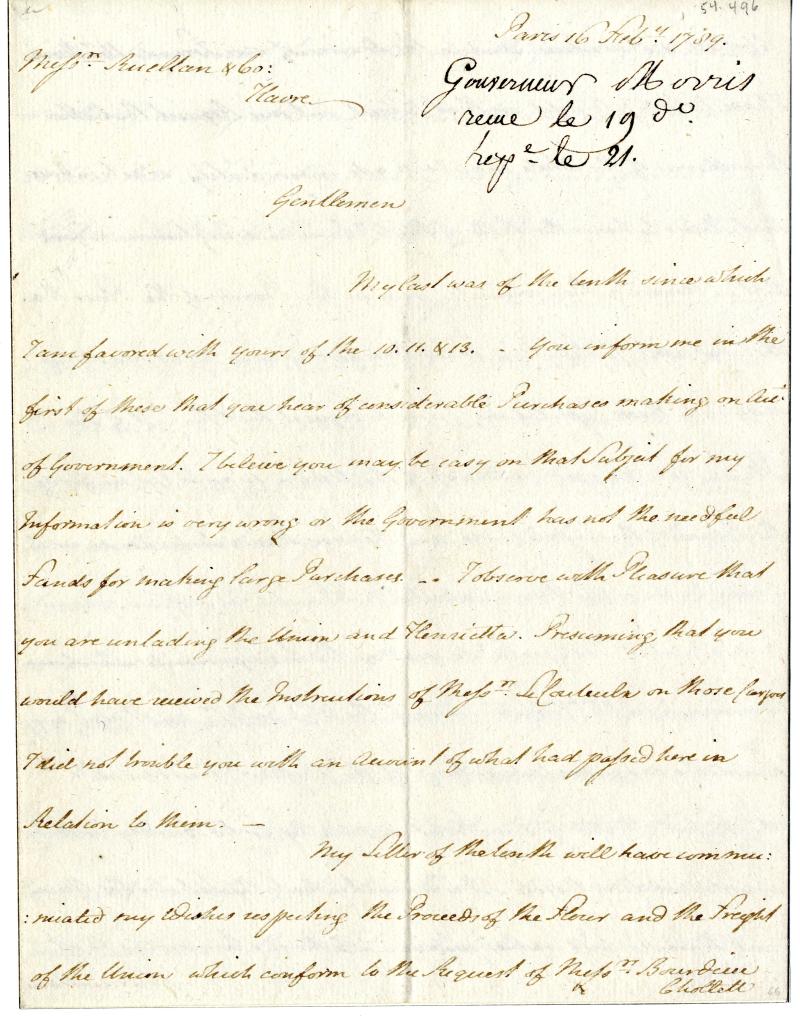
The Members of the Committee of Style
Gouverneur Morris of Pennsylvania
The DAR Americana Collection houses signatures of all of the signers of the Constitution. This is a letter from Gouverneur Morris to Messrs. Ruellan and Company of Le Havre, France, consulting a delivery of American goods, 1789.
Americana Collection, acc. 2000X-28a
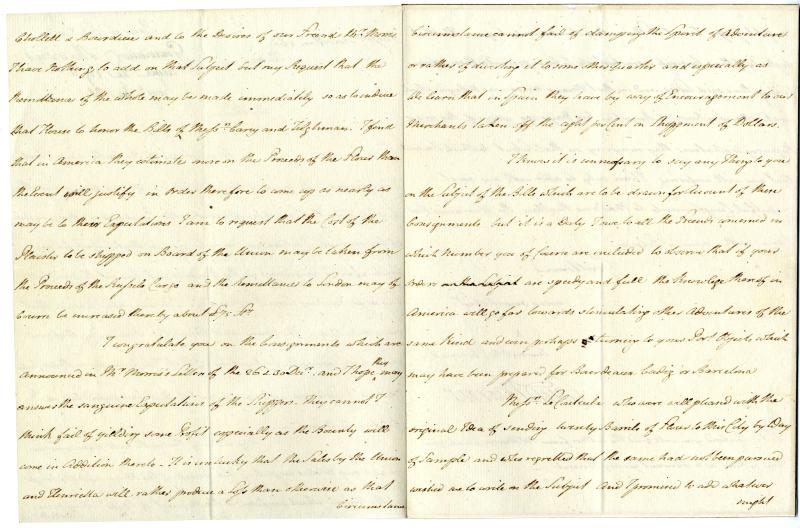
The Members of the Committee of Style
Gouverneur Morris of Pennsylvania
The DAR Americana Collection houses signatures of all of the signers of the Constitution. This is a letter from Gouverneur Morris to Messrs. Ruellan and Company of Le Havre, France, consulting a delivery of American goods, 1789.
Americana Collection, acc. 2000X-28a

The Members of the Committee of Style
James Madison of Virginia
James Madison represented Virginia at Continental Congress during the 1780s. In preparation for the Constitutional Convention he drafted the Virginia Plan, also known as the “Large-State Plan,” which outlined a strong central government with a bicameral legislature and an executive office. The Virginia Plan served as the foundation for most of the Convention’s discussions. Madison served on several committees during the Convention and was a vocal participant in deliberations. During the process of ratification by the states, Madison became the Constitution’s strongest supporter. The detailed journal he kept during the Constitutional Convention was later published and contains the most complete account of the proceedings. Madison later worked on the Bill of Rights and was one author of the Federalist Papers. He served as Secretary of State under President Thomas Jefferson and was elected president in1808. He is often called the “Father of the Constitution” for his preeminent role in its creation and ratification.
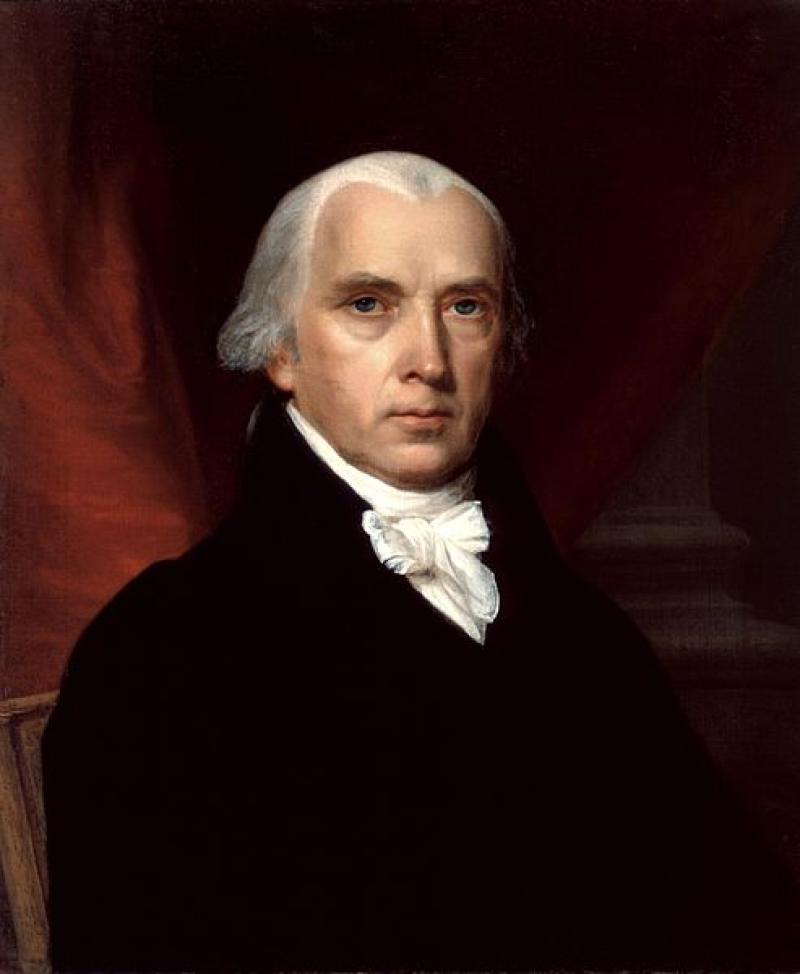
The Members of the Committee of Style
James Madison of Virginia
The DAR Americana Collection houses signatures of all of the signers of the Constitution. This is a circular issued by the Department of State and signed by James Madison regarding an amendment concerning the election of the President and Vice President of the United States, 1804.
Americana Collection, acc. 3131x-11
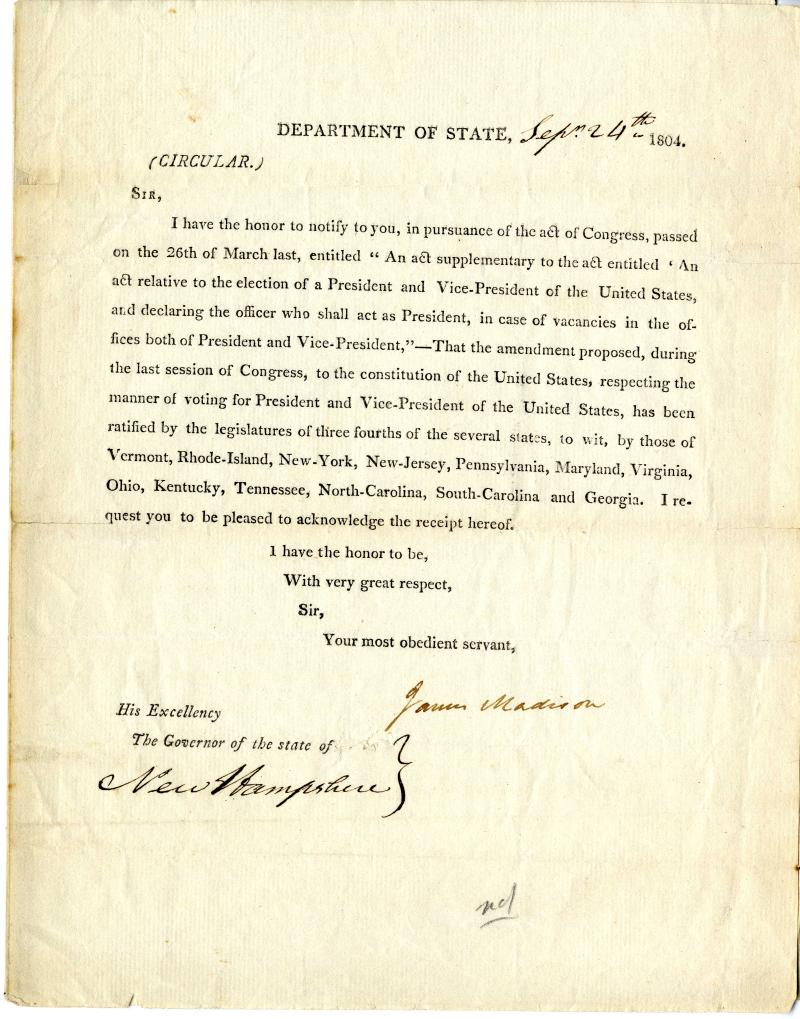
The Members of the Committee of Style
Rufus King of Massachusetts
Rufus King was born in 1755 in present day Scarborough, Maine. Amidst the American Revolution, King graduated from Harvard before briefly serving as an aide to a General. He started a law practice in Newburyport, Massachusetts and then began his political career by serving as a member of the Massachusetts Legislature, resulting in his service as a Massachusetts delegate to Continental Congress from 1784 to 1786. During this time he became well known as a brilliant orator and as an early opponent of slavery. At age 32, his state sent him to represent its interests at the Constitutional Convention. King went into the Convention thinking the Articles of Confederation needed no major changes. He is known for attending every session of the Convention, and with time he saw the need for change. King joined James Madison in promoting a federal agenda. He also worked with Alexander Hamilton in preparing the final draft of the Constitution on the Committee of Style and Arrangement.
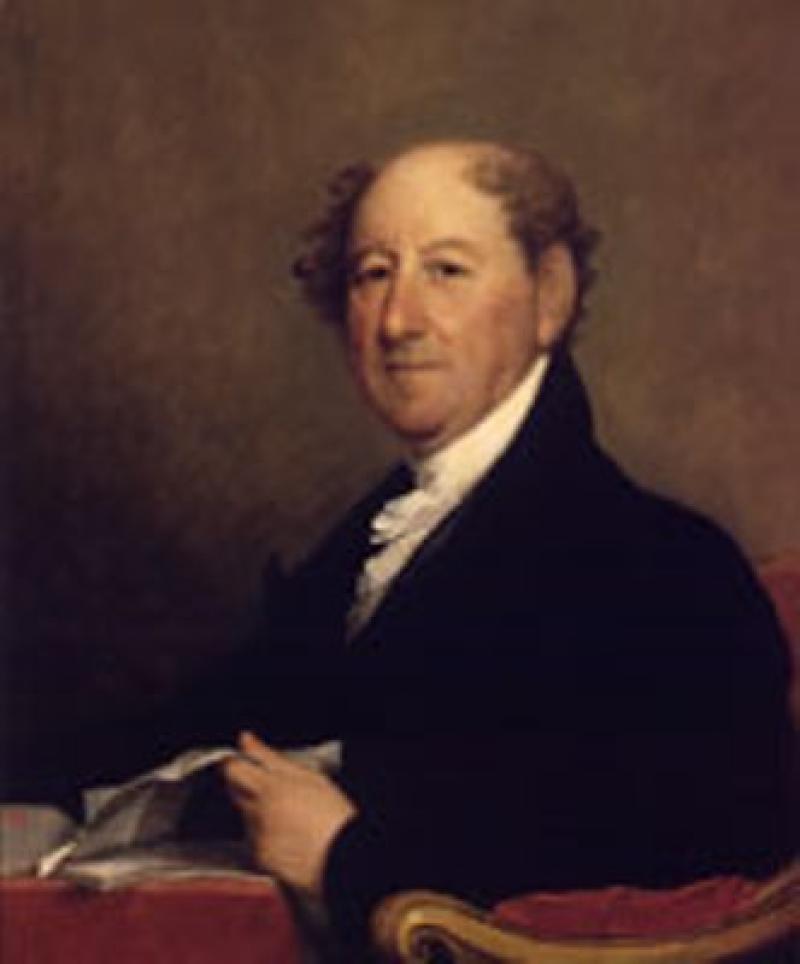
The Members of the Committee of Style
Rufus King of Massachusetts
The DAR Americana Collection houses signatures of all of the signers of the Constitution. This is a letter from Rufus King to I. Watson discussing honesty in matters of business and finance, 1792.
Americana Collection, acc. 2000x-08
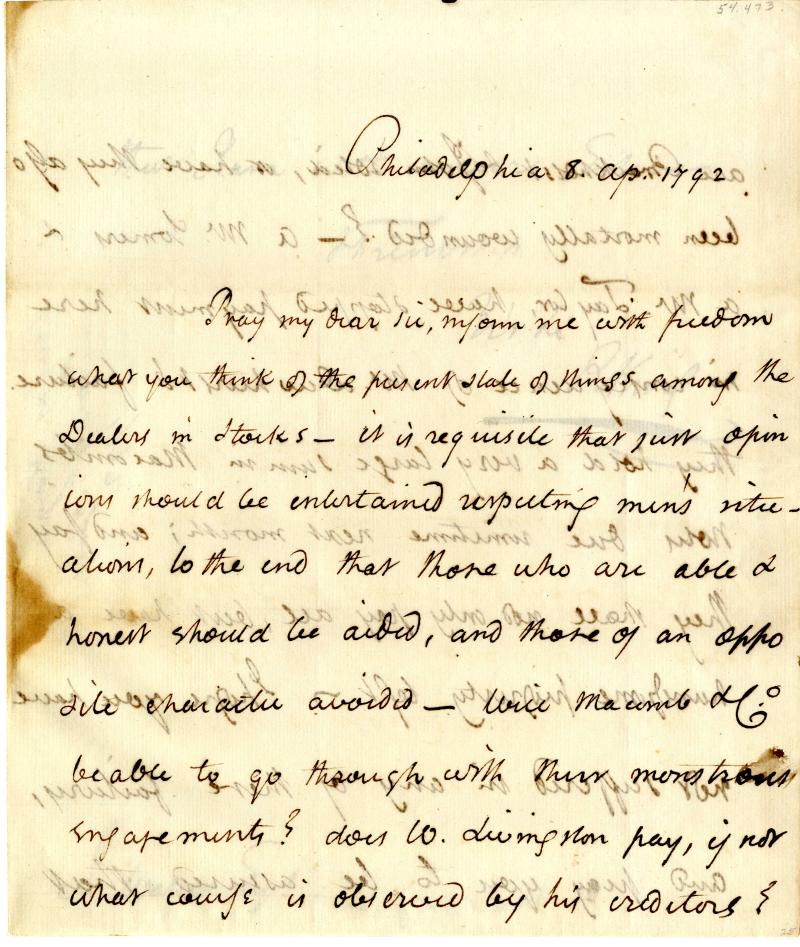
The Members of the Committee of Style
Rufus King of Massachusetts
The DAR Americana Collection houses signatures of all of the signers of the Constitution. This is a letter from Rufus King to I. Watson discussing honesty in matters of business and finance, 1792.
Americana Collection, acc. 2000x-08
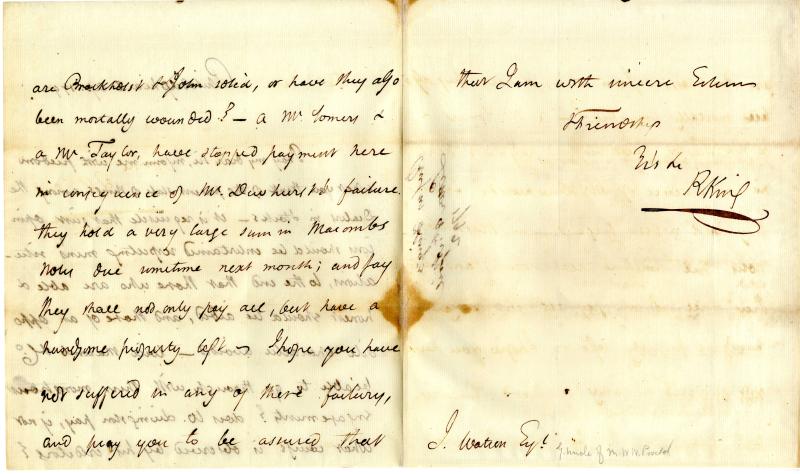
Constitution Signers
The DAR Americana Collection houses a collection of all of the signatures of the signers of the US Constitution. Click here to see their signatures and learn more about each of the signers.
